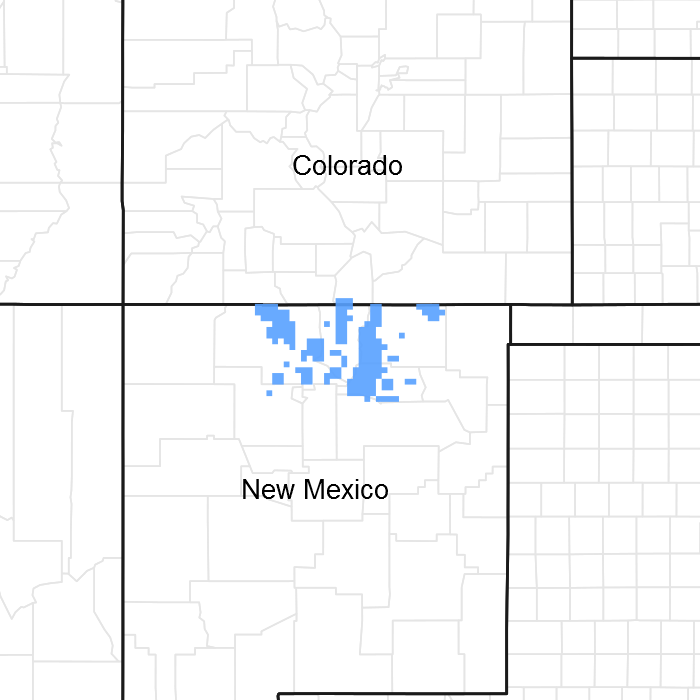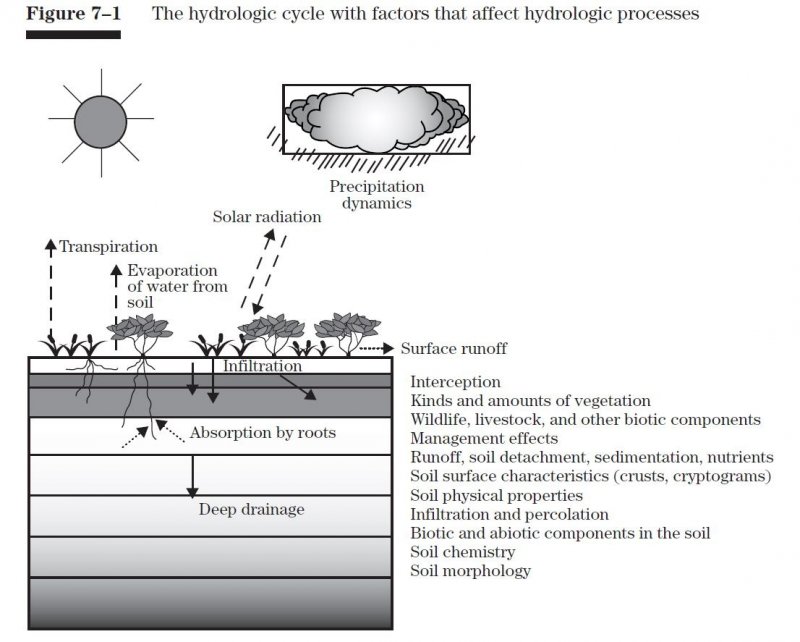
Natural Resources
Conservation Service
Ecological site R048AY003NM
Mountain Valley
Last updated: 4/02/2025
Accessed: 12/19/2025
General information
Provisional. A provisional ecological site description has undergone quality control and quality assurance review. It contains a working state and transition model and enough information to identify the ecological site.

Figure 1. Mapped extent
Areas shown in blue indicate the maximum mapped extent of this ecological site. Other ecological sites likely occur within the highlighted areas. It is also possible for this ecological site to occur outside of highlighted areas if detailed soil survey has not been completed or recently updated.
MLRA notes
Major Land Resource Area (MLRA): 048A–Southern Rocky Mountains
This area is in Colorado (76 percent), New Mexico (11 percent), Utah (8 percent), and Wyoming (5 percent). It makes up about 45,920 square miles (119,000 square kilometers). The towns Jemez Springs, Los Alamos, Red River and Eagle Nest, New Mexico, are in this MLRA. This MLRA has numerous national forests, the Carson National Forest and part of the Santa Fe National Forest in New Mexico. The Jemez, Picuris, Santa Clara, and Taos Indian Reservations are in this MLRA. Most of this area is in the Southern Rocky Mountains Province of the Rocky Mountain System. Small parts of the southwest corner and some isolated areas farther west are in the Canyon Lands Section of the same province and division. The Southern Rocky Mountains consist primarily of two belts of strongly sloping to precipitous mountain ranges trending north to south. Several basins, or parks, are between the belts. The ranges include the Sangre de Cristo Mountains, Jemez Mountains, and Tusas Mountains. Elevation typically ranges from 6,500 to 13,167 feet (1,980 to 1,039 meters) in this area. The Rio Grande is a National Wild and Scenic River in northern New Mexico, which is in the southern part of this MLRA.
The mountains in this area were formed mainly by crustal uplifts during the late Cretaceous and early Tertiary periods. The rocks exposed in the mountains are mostly Precambrian igneous and metamorphic rocks, which in many places are flanked by steeply dipping Mesozoic sedimentary rocks. Younger igneous rocks, primarily basalt and andesitic lava flows, tuffs, breccias, and conglomerates, are throughout this area. Representative formations in this area are the Silver Plume and Pikes Peak granites, San Juan Volcanics, and Mancos Shale. Many of the highest mountain ranges were reshaped by glaciation during the Pleistocene. Alluvial fans at the base of the mountains are recharge zones for local basin and valley fill aquifers. They also are important sources of sand and gravel.
The dominant soil orders in this MLRA are Mollisols, Alfisols, Inceptisols, and Entisols. The soils in the area dominantly have a frigid or cryic soil temperature regime and an ustic or udic soil moisture regime. Mineralogy is typically mixed, smectitic, or paramicaceous. In areas with granite, gneiss, and schist bedrock, Glossocryalfs (Seitz, Granile, and Leadville series) and Haplocryolls (Rogert series) formed in colluvium on mountain slopes. Dystrocryepts (Leighcan and Mummy series) formed on mountain slopes and summits at the higher elevations. In areas of andesite and rhyolite bedrock, Dystrocryepts (Endlich and Whitecross series) formed in colluvium on mountain slopes. In areas of sedimentary bedrock, Haplustolls (Towave series) formed on mountain slopes at low elevations and with low precipitation. Haplocryolls (Lamphier and Razorba series), Argicryolls (Cochetopa series), and Haplocryalfs (Needleton series) formed in colluvium on mountain slopes at high elevations
LRU notes
This site is part of the RM-1 sub-resource area. This site is found on the east side of Sangre de Cristo mountains.
Classification relationships
This ecological site is correlated to soil components at the Major Land Resource Area (MLRA) level which is further described in USDA AgHandbook 296.
Ecological site concept
This site is located in mountain valleys in the ponderosa pine zone. It has gentle to moderate slopes and receives occasional light overflow from the main stream course or adjacent side slopes. The alluvial slopes immediately adjacent to the main stream are also included in this site. Slopes are 0-5%. Along valley bottoms where drainage is poor, it may blend with the Mountain Meadow ecological site. This site differs from the Mountain Meadow ecological site in the lack of high water table. Elevation ranges from 7,000 to 9,000 feet above sea level.
Soils on this site are well drained and deep to very deep. The surface layer is loam, sandy loam or fine sandy loam with subsoil of loam, clay loam, or sandy clay loam. These soils have moderate to moderately high permeability. Runoff is medium. Available water-holding capacity is high. Effective rooting depth is 20 inches to more than 60 inches. Severe gullying can carry off most of the water, and a loss of topsoil greatly reduces water intake. Gullies that carry off extra water will drastically alter the moisture-plant relationship in many areas.
Characteristic Soils Are:
Bryan, Hesperus and Kinesava
Associated sites
| R048AY004NM |
Mountain Loam This site is on steep to moderately steep slopes on benches within the steeper slopes of the surrounding ponderosa pine tree zone. The slope is to the southwest; south and southeast, making the site directly exposed to the dry south and southwest winds and more intensive heat from the sun. Slopes vary from 5 to 70 percent. Elevation ranges from 6,900 to 9,000 feet above sea level. The soils on this site are moderately deep to deep and well drained. The surface texture is stony/cobbly silt loam or cobbly loam. The subsurface is stony loam or cobbly loam. They have a moderate permeability. The available water-holding capacity is low. Effective rooting depth is from 20 to 40 inches. There is cobble or stone throughout the profile and on the surface. Air-water-plant relationship is fair. |
|---|---|
| R048AY005NM |
Mountain Malpais This site is characterized by flat to moderately steep topography. It is frequently found as mesa, mountains slopes and ridges where the basalt caps are present. The site’s terrain may be interrupted by extrusions of the basalt, leaving a rough or choppy appearance to the topography. The basaltic stone cover typically exists over a portion of the site where igneous extrusions occur. Boulders on the surface are common. The dominant slope range is from 3 to 30 percent, but it some site range up to 55 percent. The exposure varies but has little significance on plant production. Elevation ranges from 6,800 to 9,000 feet above sea level. These soils are well drained, very shallow to shallow, and formed in debris from basalt and other volcanic rock or metamorphic rock. The surface texture is cobbly, very cobbly silt loam; stony, very stony, very cobbly loam; stony, very stony silt loam; and cobbly sandy loam. The texture of the subsoil layers ranges from very stony silt loam, very cobbly loam to extremely stony clay. The effective rooting depth is 6 to 20 inches. |
| R048AY006NM |
Mountain Meadow The site occurs as lower lying drainageways, flood plains, swales or other depressional areas where extra moisture accumulates as a result of runoff from surrounding higher sites. A high water table is characteristic of this site particularly in the spring and a portion of the area may have open water during this season. Springs or seeps bring the water table to the subsoil or even to the surface, in which instance the site may colloquially be called a “cienaga”. Slopes vary from flat to gently sloping, not to exceed 5 percent. The exposure varies and is not significant. Elevation ranges from 7,000 to 9,500 feet above sea level. These soils consist of deep to very deep soils and poorly to very poorly drained. The surface texture ranges from a very fine sandy loam to a mucky silty clay and clay surface layers. They have an active water table, which varies from the surface to 3 feet below the surface. They are normally non-saline and have high organic content. These soils have moderate to moderately slow permeability. Available water-holding capacity is moderate. The effective rooting depth is 20 inches to more than 60 inches. |
| R048AY001NM |
Subalpine Grassland This site takes in mountain parks and other open grasslands generally within the spruce-fir zone. In some places it is interspersed with aspen groves. This site is located near timberline extending down to the ponderosa pine zone. Topography is mostly rolling to moderate slopes, but some areas are steep. Slopes are between 2 to 20 percent, but can range up to 40 percent. Elevation ranges from 9,000 feet to near timberline, which is approximately 11,400 feet above sea level. The soils are well drained, deep to very deep. The surface texture is loam, cobbly loam or gravelly loam. There may be large numbers of rock fragments throughout the profile as this soil has multiple soil family particle sizes correlated to it. The soils have moderate to moderately slow permeability. Runoff is moderate. Available water-holding capacity is low to medium. The effective rooting depth is 20 inches or more. On the soil Hillery which is correlated to this site, it occurs on lava flows, mesas and plains. Hillery is also above 40 inches of precipitation which is higher than the concept of this site. Surface soil textures are silt loam, and stony loam. |
| R048AY002NM |
Mountain Grassland This site is found on the north and northeast-facing slopes at lower elevations and can be found on all exposures at the higher elevations. The site is located on open benchlands, outwash fans or exposed ridges between parks and valleys and higher mountain slopes. High mountain rims and mountain valleys are included in this site. The Mountain Grassland often occurs on benches or depressed areas within the steeper surrounding slopes of the ponderosa pine. The slopes ranges from 0 to 15 percent. Elevation ranges from 7,000 to 9,000 feet above sea level. These soils are well drained, deep to very deep. The surface layer is loam, silt loam or sandy loam. Gravel or stones are often present on the soil surface and throughout the profile but is not skeletal. These soils have a moderate permeability. Available water-holding capacity is moderate to high. Effective rooting depth is 40 inches to more than 60 inches. |
Similar sites
| R048AY002NM |
Mountain Grassland This site is found on the north and northeast-facing slopes at lower elevations and can be found on all exposures at the higher elevations. The site is located on open benchlands, outwash fans or exposed ridges between parks and valleys and higher mountain slopes. High mountain rims and mountain valleys are included in this site. The Mountain Grassland often occurs on benches or depressed areas within the steeper surrounding slopes of the ponderosa pine. The slopes ranges from 0 to 15 percent. Elevation ranges from 7,000 to 9,000 feet above sea level. These soils are well drained, deep to very deep. The surface layer is loam, silt loam or sandy loam. Gravel or stones are often present on the soil surface and throughout the profile but is not skeletal. These soils have a moderate permeability. Available water-holding capacity is moderate to high. Effective rooting depth is 40 inches to more than 60 inches. |
|---|---|
| R048AY014NM |
Mountain Valley Dry This site occurs on broad valleys, overflow areas adjacent to intermittent streams and depressional areas subject to run-in of moisture from adjacent sites. However, this site is often highly dissected, and run-in is non-effective. Slopes range from 1 to 8 percent. Elevation ranges from 7,200 to 8,000 feet above sea level. The soils are deep to very deep and well drained. Surface textures is usually clay loam. Subsoils is usually clay. This ecological site used to have the ID number of R048BY007NM in RM-2 subresource area in 1982. |
Table 1. Dominant plant species
| Tree |
Not specified |
|---|---|
| Shrub |
(1) Artemisia frigida |
| Herbaceous |
(1) Muhlenbergia montana |
Click on box and path labels to scroll to the respective text.
